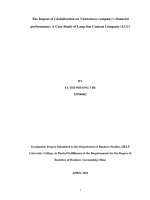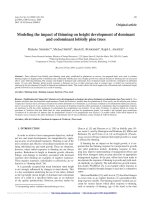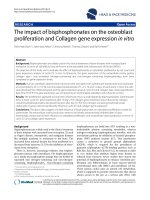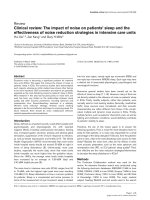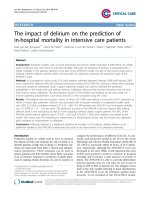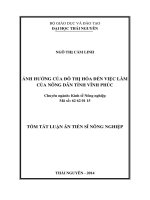The impact of remittances on financial development in selected Asian countries
Bạn đang xem bản rút gọn của tài liệu. Xem và tải ngay bản đầy đủ của tài liệu tại đây (2.06 MB, 92 trang )
UNIVERSITY OF ECONOMICS
HO CHI MINH CITY
VIETNAM
ERASMUS UNVERSITY ROTTERDAM
INSTITUTE OF SOCIAL STUDIES
THE NETHERLANDS
VIETNAM – THE NETHERLANDS
PROGRAMME FOR M.A IN DEVELOPMENT ECONOMICS
THE IMPACT OF REMITTANCES ON
FINANCIAL DEVELOPMENT IN
SELECTED ASIAN COUNTRIES
BY
HUYNH THI MY CHI
MASTER OF ARTS IN DEVELOPMENT ECONOMICS
HO CHI MINH CITY, DECEMBER 2016
UNIVERSITY OF ECONOMICS
HO CHI MINH CITY
VIETNAM
INSTITUTE OF SOCIAL STUDIES
THE HAGUE
THE NETHERLANDS
VIETNAM - NETHERLANDS
PROGRAMME FOR M.A IN DEVELOPMENT ECONOMICS
THE IMPACT OF REMITTANCES ON
FINANCIAL DEVELOPMENT IN
SELECTED ASIAN COUNTRIES
A thesis submitted in partial fulfilment of the requirements for the degree of
MASTER OF ARTS IN DEVELOPMENT ECONOMICS
By
HUYNH THI MY CHI
Academic Supervisor:
DR. NGUYEN VAN NGAI
HO CHI MINH CITY, DECEMBER 2016
DECLARATION
“This declaration is to certify that this thesis entitled “The Impact of Remittances
on Financial Development in Selected Asian Countries” which is conducted and
submitted by me in partial fulfilment of the requirements for the degree of the
Vietnam – The Netherlands Programme.
The thesis constitutes only my original works and due supervision and
acknowledgement have been made in the text to all materials used.”
Huynh Thi My Chi
ACKNOWLEDGEMENTS
I would like to express my greatest appreciation to persons who greatly supported
and contributed to this thesis by supervision and encouragement.
First of all, I am deeply grateful to my supervisor, Assoc., Prof. Nguyen Van Ngai,
for his guidance, enthusiasm, support, dedication and invaluable comments and
advices. It was my privilege to have his supervision. Without his encouragement
and support, I would not have been able to complete this thesis.
I am also very obliged to Prof. Nguyen Trong Hoai, Dr. Pham Khanh Nam for
their valuable comments and suggestions for my Concept Note and Thesis
Research Design. My special thanks to Dr. Truong Dang Thuy for his
encouragements, advices and enthusiasm to help me finish the thesis. I would also
like to thank all VNP staff for their diligent assistance.
I am thankful to my friends from VNP who supported, encouraged and shared
experiences for my thesis completion. Besides, my sincere thankfulness also goes
to my company’s managers and colleagues who kindly and understandingly
facilitated my master studying.
Finally, I am most grateful to my family for their endless support and
encouragements to me all the way through my journeys.
ABBREVIATIONS
FDI
: Foreign Direct Investment
FEM
: Fixed Effect Model
GDP
: Gross Domestic Product
GDPPC
: Gross Domestic Product Per Capita
GMM
: Generalized Method of Moments
ODA
: Official Development Assistant
REM
: Random Effect Model
ABSTRACT
Although the impact of remittances on economic growth and poverty has always
been a controversial problem for researchers and policy makers as remittance
inflow have been becoming one of the largest external capital sources for many
countries, its direct effect on financial development merely attract more attention
after the financial crisis of 2007-2008. In an effort to contribute to empirical
studies on this issue, this study utilizes fixed effect, random effect and system
Generalized Method of Moments (GMM) to investigate the direct impact of
remittances on two dimensions of financial development comprising the
percentage of domestic credit to private sector by banks and broad money to GDP
in thirty-seven Asian countries during the period 1990-2014. Furthermore, this
study also examines whether there are different effects of remittance inflows in
high, middle and low-income countries in this area. The results show that an
increase in remittances seems to have no impact on financial development in
general while there are mix results regarding the different income groups of
countries in Asia. In particular, while no evidence on the impact of remittances on
both measurements of financial development as the whole region are obtained in
middle and low-income countries, there is a significant and positive effect of these
flows on the ratio of domestic credit to private sector by banks to GDP despite an
insignificant influence on broad money to GDP in high income countries.
Keywords: Remittances, Financial development, Asia, Income Group.
TABLE OF CONTENTS
LIST OF TABLES .....................................................................................................
LIST OF FIGURES....................................................................................................
CHAPTER 1: INTRODUCTION ............................................................................ 1
1.1.
Problem statement ...................................................................................... 1
1.2.
Research objectives .................................................................................... 3
1.3.
Scope and data of the study ........................................................................ 3
1.4.
Structure of the study.................................................................................. 5
CHAPTER 2: LITERATURE REVIEWS ............................................................... 6
2.1.
Theory of remittances and financial development ..................................... 6
2.1.1.
The concepts and channels of remittances........................................... 6
2.1.2.
Definitions of financial development .................................................. 7
2.1.3.
The role of remittances in financial development .............................. 7
2.2.
Empirical studies ...................................................................................... 10
2.3.
Other determinants of financial development .......................................... 15
CHAPTER 3: MODEL SPECIFICATION AND DATA ...................................... 18
3.1.
Model specification .................................................................................. 18
3.2.
Data sources .............................................................................................. 21
3.3.
Estimation methods .................................................................................. 23
3.3.1.
Pooled OLS model ............................................................................. 24
3.3.2.
Fixed effect model ............................................................................. 25
3.3.3.
Random effect model ......................................................................... 26
3.3.4.
Tests for choosing sufficient model ................................................... 26
3.3.5.
The system generalized method of moment estimation .................... 28
CHAPTER 4: THE IMPACT OF REMITTANCES ON FINANCIAL
DEVELOPMENT IN ASIA ................................................................................... 31
4.1.
Overview of remittance inflows and financial development in Asia ....... 31
4.1.1.
Overview of remittance inflows to Asia from 1990 to 2014 ............. 31
4.1.2.
Overview of financial development in Asia from 1990 to 2014. ...... 36
4.2.
Empirical results ....................................................................................... 40
4.2.1.
Descriptive statistic ............................................................................ 40
4.2.2.
Empirical results ................................................................................ 45
CHAPTER 5: CONCLUSIONS AND POLICY IMLICATIONS ........................ 54
5.1.
Conclusions .............................................................................................. 54
5.2.
Policy implications ................................................................................... 55
5.3.
Limitations and further researches ........................................................... 56
REFERENCES ...........................................................................................................
APPENDIX I ..............................................................................................................
APPENDIX II: THE REGRESSION RESULTS ......................................................
LIST OF TABLES
Table 3.1: The definition and expected sign of variables ......................................22
Table 4.1: The summary statistics of variables .......................................................41
Table 4.2: The correlation between variables ........................................................44
Table 4.3: The results of tests for choosing models ................................................45
Table 4.4: The results of FEM with robust .............................................................47
Table 4.5: The results of system GMM ..................................................................49
Table 4.6: Summary of the impact of remittances on financial development in Asia
and different income groups by FEM and system GMM .......................................50
LIST OF FIGURES
Figure 4.1: Remittances received by areas in the world from 1990 to 2014 (US$
billion) .....................................................................................................................31
Figure 4.2: Top 10 remittance recipient countries in 2014 (US$ billion) ...............32
Figure 4.3: Top 10 remittance recipient countries in 2014 (% GDP) .....................33
Figure 4.4: Remittances to areas in Asia from 1990 to 2014 (US$ billion) ...........34
Figure 4.5: Remittances received by income groups in the world from 1990 to
2014 (US$ billion)...................................................................................................35
Figure 4.6: Remittances received by income groups in Asia from 1990 to 2014
($US billion)............................................................................................................36
Figure 4.7: Domestic credit to private sector by banks (% of GDP) in Asia from
1990 to 2014 ............................................................................................................37
Figure 4.8: Broad money as % of GDP in Asia from 1990 to 2014 .......................38
Figure 4.9: The average ratio of domestic credit to private sector by banks to GDP
across income groups in Asia (%) ...........................................................................39
Figure 4.10: The average ratio of broad money as % of GDP across income groups
in Asia .....................................................................................................................39
Figure 4.11: Correlation between domestic credit to private sector by banks
(%GDP) and remittance inflows (%GDP) and other controlling variables ............42
Figure 4.12: Correlation between broad money (%GDP) and remittance inflows
(%GDP) and other controlling variables .................................................................43
CHAPTER 1: INTRODUCTION
1.1. Problem statement
Together with the augmentations of migration flows in recent decades,
remittances - money sent by migrants to home countries - have grown rapidly
and appeared to surpass main conventional channels like official development
assistant (ODA), private capital (Dilshad, 2013). According to the data from
World Bank, in 2014, personal remittances recorded worldwide are up to onethird of foreign direct investment (FDI) and more than three times as large as
the sum of ODA and official aids, from US$ 67 billion in 1990 to over US$
533 billion. Moreover, while foreign direct investment (FDI) fluctuates wildly
during the period from 2000 to 2014, ODA and other external sources remain
either unchanged or even decrease substantially; remittances keep its routine
to accelerate stably over time. In particular, officially recorded remittances
worldwide declined the first time in 2009 since 2000. Nevertheless, the
decrease in remittance inflows by nearly 5 percent in 2009 compared to the
remittance amount in 2008 due to global financial recession was trivial, in
comparison with a 45 percent decrease in FDI in the same year. After that,
while remittances have been totally recovered and continued to rise, FDI
already fell twice in 2012 by nearly 10 percent and in 2014 by 20 percent.
As the stability and increment of remittance inflows has drawn enormous
attention from researchers and policy makers in recent decades, a strong wave
of papers and studies have dug into links between these flows and various
aspects of economic development. However, while most investigations have
attempted to figure out effects of remittances on growth, poverty, education,
less effort has been spent for studying the linkage between remittance inward
flows and financial development, which has been documented to foster
economic growth and reduce poverty by literature extensively (Goldsmith,
1969; Bencivenga and Smith, 1991; King and Levine, 1993; Beck, Demirguc-
1
Kunt and Levine, 2004), across recipient countries despite their important
contribution in total external financial sources.
Moreover, various perspectives relating to this relationship argue different
channels via which remittance flows may affect financial sectors, and
empirical studies examining the impact of remittances on financial
development also demonstrate inconsistent outcomes across countries and
areas. On the one view, these flows may enhance financial development if
formal financial channels are utilized in order to conduct transactions relating
to remittances, recipients are acknowledged financial services; thereby
permitting banks to get acquainted or approach unbanked recipients. At the
same time, that other financial products might be need if recipients prefer to
store surplus income fosters the development of banking products and
services. (Orozco and Fedewa, 2006; Gupta, Pattillo and Wagh, 2009;
Aggarwal et al., 2011; Demigüç-Kunt et al., 2011). Furthermore, playing as a
collateral role, remittance flows may enlarge bank willingness to provide loans
for families with stable remittances. Even in the case remittances cannot
become sufficient collateral, overall credit might still surge through recipient
communities due to the incremental loanable funds as a result of remittances
deposited to banks (Chami et al., 2009).
On the other view, remittances might impede the development of financial
sectors if remittance inflows loosen recipients’ budget constraints and allow
them to lower their demand for outside credit (Martínez, Mascaró and
Moizeszowicz, 2008; Brown et al., 2011). Recipients might also consider
remittances as additional income and utilize most of them for consumption, or
their distrust of financial sectors might discourage them to deposit money to
banks, therefore no need for financial products and no increase in bank
deposits (Chami et al., 2009). As a result, whether, how and to what extent
remittances impact financial developments in remittance recipient countries
2
are still complicated issues, hence the need for more studies to investigate
these effects.
In an effort to address the relationship between remittances and the
development of financial sector in Asia, this study utilized a panel data from
1990 to 2014 for thirty-seven Asian countries and different econometric
methods. In particular, the linkage of personal remittances and financial
development’s indicators comprising domestic credit to private sector
provided by banking system and broad money are analyzed with fixed effect,
random effect and system Generalized Method of Moments method.
Furthermore, based on the level of country’s income which is classified by
World Bank, this study also examines whether there are different effects of
remittance inflows in high, middle and low-income countries in this area.
1.2. Research objectives
This study is conducted in an attempt to:
Analyze the trend of remittance inflows and the situations of domestic
credit to private sector provided by banks and broad money in Asia region,
Access the impact of remittances on financial development in Asia in
general,
Evaluate different impacts of remittance flows on financial development in
different income-groups of countries in Asia.
From the findings, this study will propose recommendations in order to foster
the effects of remittance inflows on financial development in Asian remittance
recipient countries.
1.3. Scope and data of the study
This research investigates whether remittances have significant influence on
financial development for Asian countries due to many reasons. First,
remittances flowing to Asia have accelerated substantially in the recent decade
3
and captured nearly 50% total remittance inflows in the world. Especially
many middle and low income countries have taken large parts in both
numerical value and percentage of Gross domestic product (GDP) in the
amount of remittances flowing to this area; nonetheless, the development
impact of remittances on financial sectors has not been commensurately
analyzed in this area.
Second, researches on studying the impact of remittances on financial
development are solely officially conducted for separate country or a part of
Asia. For example, Chowdhury (2011) finds that there is a direct positive
relationship between remittance flows and financial breadth and depth in
Bangladesh while Noman and Uddin (2012) provides evidences of for an
indirect impact of remittances on banking sector and economic growth in
selected South Asia countries.
Third, as previous studies have chosen sample basing on the division of
developing and developed countries which may affect results when high
tolerance among the income of countries may be occurred among those types
of countries. Hence, it is necessary for studying the linkage of remittances and
financial development in this area. Specially, investigation on the impacts of
these flows on different income groups will provide a better view for policy
makers.
Finally, from the impact of remittances on financial development in Asia,
several recommendations may be suggested in the case of Vietnam, one of
Asian middle-income countries whose remittance inflows have been accelerate
from US$1.34 million in 2000 to over US$13 million and account for nearly
7% of GDP in 2015.
Hence, there is a need for investigating the impact of remittances both in
general and in separate income groups in Asia. Data of selected Asian
countries collected for the period from 1990 to 2014 are employed in this
4
study. Except for financial openness indicator which is represented by The
Chinn-Ito Index (Chinn and Ito, 2006), the remained data are extracted from
the database of World Bank.
1.4. Structure of the study
This thesis consists of five chapters. Chapter 1 presents the motivation for
scrutinizing the nexus between remittances and financial development in
Asian countries. Chapter 2 provides concepts of remittances and reviews vital
literature relating to perspectives on the role of remittances to financial sectors
and empirical studies considering the effects of remittances and other variables
on financial development. Chapter 3 demonstrates the research methodology
in tandem with data utilized in this study. Chapter 4 presents an overview of
remittances and financial development in Asia during the period 1990-2014
and analyzes empirical results derived from regression. The last chapter
summarizes main findings, proposes policy recommendations; moreover,
limitations and future researches are also mentioned in this chapter.
5
CHAPTER 2: LITERATURE REVIEWS
This chapter comprises three parts. First part presents concept and channels of
remittances, definitions of financial development and main perspectives on the
effect of remittances on financial development. Previous empirical studies on
the relationship between remittance inflows and financial development will be
present in the second part. The last part delivers former papers investigating
the impact of main macroeconomic and openness factors to financial
development.
2.1. Theory of remittances and financial development
2.1.1. The concepts and channels of remittances
The term “Remittances” has been used commonly recently but it is rarely
defined. In many previous papers, remittances are defined generally as the
cross-border money that migrants send back to their home countries
Remittances may be transferred via either official or unofficial channels.
Official transfers refer to transactions utilizing the banking system or money
transfer organizations. Unofficial transfers are sent mainly in cash through
friends, family members, migrants themselves or via traditional channels,
called hawala in some countries, by which money may be deposited with an
unlicensed organizations in one country and may be drew at their partners in
the recipient country (Freund and Spatafora, 2008; Nyamongo, 2012; Giuliano
and Ruiz-Arranz, 2005; Aggarwal et al., 2011).
As mentioned in literature, informal channels are utilized widely for
transferring remittances in the world due to the accessibility, anonymity, low
cost, reliability. First, both the remittance senders and receivers do not need to
have bank account or prepare complex procedures which are required at banks
or official organizations. Second, the information relating to the transactions
can be remained unknown with other people. Third, the cost of these transfers
is lower than they should be when utilizing official channels. Finally, that
6
remittances are delivered via the networks of family members or friends
creates the reliability especially for people who seldom used official financial
organizations.
Nevertheless, utilizing informal channels induce some consequents. First,
official organizations may encounter difficulties in collecting data and make a
miscalculation the volume of remittances. Second, criminal organizations or
individuals can use remittances for money laundering. Finally, diminishes the
financial development impact of remittances as envisaged by the proponents
of financial development (Nyamongo, 2012).
2.1.2. Definitions of financial development
According to the definitions of World Bank, financial sector is the
combination of institutions, instruments, markets, and the legal and regulatory
framework that permit transactions to be made by extending credit. Primarily,
to develop the financial sector is to overwhelm “costs” arise in the financial
system. The process of cost reduction in obtaining information, enforcing
contracts, and conducting transactions leads to the appearance of financial
contracts, markets, and intermediaries. Diverse kinds and conjunctions of
information, enforcement, and transaction costs with various legal, regulatory,
and tax systems have inspired distinctive financial contracts, markets, and
intermediaries across nations and throughout history.
Financial development appears when there are improvements in financial
instruments, markets, and intermediaries although these improvements may or
may not remove the burdens of information, enforcement, and transactions
costs (Levine, 2005).
2.1.3. The role of remittances in financial development
Different perspectives on the impact of remittances on financial development
in recipient countries at the theoretical level have been mentioned in many
previous studies. The first argument is that remittance inflows foster financial
7
sector on both demand and supply aspects. With regard to the demand side,
remittances is assumed to enhance financial literacy within remittance
recipient communities when migrants and remittance recipients adopt formal
transfer channels, thereby accelerating requirements for and utilization of
banking products and services (Orozco and Fedewa, 2006; Gupta, Pattillo and
Wagh, 2009). For instance, the need for channels through with remittances can
be transferred or received can increase the opportunities of searching
information related to products offered by banks; hence, stimulating the need
and usage of various financial products and services and increasing the
chances for banks to approach un-banked recipients, which permit for their
outreach expansion. It is also argued that even if these flows of remittances are
not transacted through banks, money surpluses created by additional income
from remittances might potentially stimulate the acquisition of other banking
services as people feel necessity for a means to store or invest the excess
balances (Aggarwal et al., 2011; Demigüç-Kunt et al., 2011).
Regardless of supply side, remittances are also presumed to promote the
development of breadth and depth of financial sectors. For example, banks are
encouraged to provide more products and services or even more branches to
satisfy the growing requirement of remittance recipients. Furthermore, banks
might be obligingly permit or increase credit for remittance recipients with
stable and considerable remittance receipts as they become more attractive and
potential customers. Additionally, augmentation in loanable fund deposited to
banks by remittance recipients along with the costs of transactions related to
sending, receiving or storing remittances may result in rise of bank credit to
communities (Giuliano and Ruiz-Arranz, 2005; Toxopeus and Lensink, 2008;
Aggarwal et al., 2011). Consequently, financial systems in recipient
economies may be further widening and deepening, and it is essential to
investigate the impact of remittances on financial development at the country
level.
8
In the second view, remittances may create deleterious effects on financial
development since individuals with remittance receipts may relax their budget
constraints and lower credit demand which may be needed from financial
organizations otherwise (Caceres and Saca, 2006; Martínez, Mascaró and
Moizeszowicz, 2008; Aggarwal et al., 2011). Moreover, it is worse in case a
pattern of conspicuous consumption is developed along with the inability to
promote a saving habit that can assist investments and economic growth.
In the third view, remittance inflows may have no impact on stimulating
financial development in many countries, especially in countries with less
developed financial systems due to many reasons (Brown et al., 2011). Above
all, migrants prefer to transfer money to home countries through informal
transfer ways rather than formal channels then there might be no need for
recipients to be aware of or utilize bank transfer services. As unbanked –
receivers do not have acknowledge of banking products and services, namely
financial literacy is not increased in the communities, the need for financial
systems does not exist or rise. Moreover, remittance recipients might store
excess money at home or utilize them for other purposes as they might distrust
banks and other financial institutions, or spend most of them for consumption;
hence, there is no demand for saving products provided by banks or other
formal financial products. These behaviors of remittance recipients might
result in neither growth nor harmfulness on financial sector performance.
Besides debates on the impact of remittances on financial development, the
adverse causality is also argued from different level of financial sector
performance (Brown et al., 2011). Lacking of development financial system
and accessibility of commensurate quantity of banks and other formal
financial institutions within the remittance recipient countries may lead to
distrust of this sector among unbanked individuals or insufficient adaptation
for the demand of financial products and services, hence driving individuals to
rely more on informal channels for transaction related to remittances. In
9
contrast, higher level of financial development might enhance the trust of
individuals in financial sectors and stimulate the demand for financial products
and services. Furthermore, lower cost of transferring remittances as a result of
financial development might foster utilization of these services of both
remittance senders and receivers.
2.2. Empirical studies
Various methods and datasets have been utilized to access the effects of
steadily accelerating remittance inflows on financial development in the world
in recent decades; the approaches of the above relationship in those papers can
be categorized in two main strands comprising indirect and direct link. For the
indirect approach, researchers explore the nexus of remittances and financial
development indirectly by analyzing whether remittances foster economic
growth at given level of financial development. With regard to the direct
approach, the impact of remittances on financial development is investigated
directly to evaluate the widening and deepening effect of remittances on
financial sector performance.
The first indirect group of studies focusing on the relationship of remittances
and growth while considering interactions between remittances and financial
development derives two main contrary aspects relating to whether country’s
financial development is less developed or relatively developed. On the one
hand, in a country lacking in financial development, remittances are believed
to play an important role in providing additional sources for capital market,
thereby promoting investment and economic growth. For instance, by adding a
representative variable for financial development in tandem with remittances
in growth equations while analyzing for sample of over 100 countries from
1975 – 2002 with GMM approach, Giuliano and Ruiz-Arranz (2009) find
strong evidence that remittance inflows enhance economic growth by
providing an alternative financial source for investment and mitigating credit
10
constraints for countries with less developed financial systems. The findings
remains unchanged for different measures of financial system development
utilized in the paper after controlling for the problem of endogeneity emerged
by the causal relationship between remittance inflows and financial
development. This paper also provide proof that there may exist an investment
channel via which inflows of remittances can boost economic growth,
especially in case the credit offered by financial sector does not fulfill to the
population demand. The role of remittances in providing external sources for
investment is weaker in countries with quite developed financial sectors as the
availability of credit lowers the needs of remittances for investment intentions.
Ramirez and Sharma (2008) also acquires analogous outcome as Giuliano and
Ruiz-Arranz (2009), indicating that remittances may boost economic growth
more in country with weak financial development when utilizing unit root test,
cointegration test and fully modified ordinary least square method for a dataset
of twenty-three upper and lower income countries in Latin American and
Caribbean area for the period of 1990 – 2005. Nevertheless, this study shows
supplementary outcome that impact of remittances on economic growth in the
upper income group is stronger than in the lower income group. Besides, the
study also presents other channels through which remittances can positively
influence economic growth such as the degree of education and economic
liberalization.
On the other hand, the impact of remittances on growth may be stronger in
countries with more developed financial systems since the immense
accessibility of financial products and services give assistance in orientating
remittances to more effective usage or investment. Mundaca (2009) shows this
by utilizing a cross-countries panel of Latin America and the Caribbean
covering the period of 1970 – 2002 to analyze his theoretical model. Utilizing
First Difference GMM to solve the possible endogeneity, this paper concludes
that remittances are appeared to boost further growth in countries with proper
11
developed financial system which can direct remittance inflows to invest in
technology or other capital; besides, another important finding of this study is
that when remittance proxy is added in growth equation, the impact of per
capita investment on economic growth increases substantially. The studies of
Ojeda (2003), Terry and Wilson (2005), and World Bank (2006) also support
for the above findings by presenting the similar results that channeling
remittances for better profitable investments through the formal financial
sector accelerates the development impacts of remittances.
Bettin and Zazzaro (2011) also obtain similar results when investigating the
relationship of remittance inflows and the level of financial development.
Utilizing a panel dataset of sixty-six developing countries over the period
1970 – 2005 with system GMM in tandem with adding a new representative of
the development of financial system to gauge the banking performance
efficiency in remittance-receiving countries, they find that remittance inflows
contribute to the economic growth in countries whose banking systems operate
well.
In this first approach studies group, nevertheless, the financial development
degree is given and the direct impact of remittance inflows on financial
development in the recipient economy is neglected. Hence, researches have
been investigated influences of remittances on the development of financial
sectors more directly as remittances have shown their gradually increasing
important effects on the development of economic.
Taking into account the limitations of indirect approach in the first group of
studies, the second strand of empirical studies has been investigated more
direct impact of remittances on financial development in the recipient country
with mix results in the recent years. The outcome that appears quite frequently
in recent papers is that remittances promote financial development in many
countries. For instance, Gupta et al. (2009) shows this when examining the
12
remittances – financial development linkage and financial development –
poverty nexus by employing a panel data of 44 Sub-Saharan Africa countries
over the 1975-2004 periods with three stage least square, fixed effects and
random effects models of regression along with six years period averages. The
results show that remittances in this area, which are still small in comparison
with other aid flows, but with a stable and gradually increasing volume during
the study period, have a significant positive impact on financial development
and direct effect on poverty alleviation. These findings remain unchanged
after dealing with reverse causality which may exists when assessing the
relationship between remittances and financial development or poverty in this
area.
Demirguc-Kunt et al. (2010) present evidences of a direct positive impact of
remittance inflows on the banking sector’s breadth and depth by analyzing
county-level data for households and banking sectors comprising the number
of bank branches, the number of bank accounts and value of bank deposits
and credit in Mexico in 2000. In detail, the study shows that the higher the
proportion of the population has remittances in a county, the higher the
number of bank branches, the number of bank accounts and value of bank
deposits exist in that county after taking into consideration of the potential
endogeneity. When the portions of households who receive remittances grow
by one percentage, the proportion of households utilizing financial products
and services will be increased by nearly 0.16 to over 0.19 percentages.
Aggarwal et al. (2011) obtain the analogous outcome when examining the
nexus between remittance inflows and financial systems development in
recipient economies by utilizing a large sample of 109 developing countries
over the periods from 1975 to 2007 with various research methods comprising
fixed effects estimations, dynamic system GMM, and instrumental variables
(IV) estimations. As bank credit and deposit to private sector expressed in
proportion of GDP represented for the performance of financial sectors, this
13
study finds that worker remittances have a direct and positive significant
influence on the aggregate bank credit and deposit to private sector in
developing countries after considering for variable omission, reverse causality
and measurement errors effects.
Cooray (2012) also provide evidence for the association of remittances and
financial sector when examining the annual dataset of 94 non-OECD countries
over the period from 1990 to 2010 with pooled OLS and system GMM. The
study analyzed the effects of remittance inflows on the size and efficiency of
financial systems, and the results show that remittances increase these two
dimensions of financial systems. The study, furthermore, examines the
correlation of remittances on above two measurements of financial sectors via
their interaction with the government ownership of remittance-receiving
countries’ banks. The outcomes indicate that the lower the government owner
ship of bank a country has, the higher the impact of migrant remittances on the
enlargement of the size of financial sector in countries. Nevertheless, the
higher increase in the efficiency of financial sectors required the higher
government ownership of banks.
With regard to Asia, Chowdhury (2011) investigates whether remittance flows
have positive contribution to the development of the financial sector in
Bangladesh with annual dataset from 1971 to 2008 and Cointegration and
Vector Error Correction Model method. The study provides evidence for
significant and positive effects of remittance inflows on widening and
deepening the financial system in this country. The results also indicate that
remittance inflows and indicators of financial development do not have
reverse causation when applying test for endogeneity bias.
Even though most of studies favor the association between remittances and
financial development as presented in above studies, other researches still find
evidences for different results as remittances appeared to have no or negative
14
effects on the development of financial sectors. Brown et al. (2011), for
instance, show evidence that migrants’ remittances have no effect or impede
financial development when examining this nexus on both macro as well as
micro level. On macro level, researchers collected a dataset of 138 countries of
world for the period of 1970 to 2005 and incorporated fixed effects model of
panel data and Probit model in exploring financial development and
remittances. On the other hand, at micro level, data are collected from 3,899
households from Azerbaijan and 3,995 households from Kyrgyzstan. The
study finds that remittances seem to have no effect or even have deleterious
effect on financial development at macro level. At micro level, the study find
an inverse impact of remittances from both perspectives households as well as
community in Azerbaijan while there appears a direct impact of remittances
with both sources households and community in Kyrgyzstan.
2.3. Other determinants of financial development
Beside remittances, former papers have indicated main macroeconomic and
openness variables which have effect on financial development comprising
country size, GDP per capita, inflation, financial openness and trade openness.
With regard to country size, Goldsmith (1969) and Gurley and Shaw (1967)
find that the growth of an economy leads to the increase in the needs for
financial products and services; and financial sector accommodate itself to
those growth requirements. Such increment in demand will foster more
sophisticated and advanced financial intermediaries in order to meet new need
for their products and services (Yartey, 2008).
Concerning the economic development and quality of country legal
institutions, it is supposed that higher income may encourage higher rate of
savings leading to the increment of supplementary financial instruments which
assists channeling these flows into better investment (Kamar and Ben Naceur,
2007; Yartey, 2008). On the other hand, it is wisely founded that bad
15


